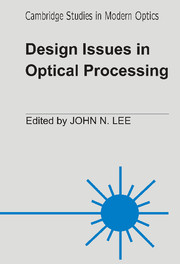Book contents
- Frontmatter
- Contents
- List of Contributors
- Preface
- 1 How optical computers, architectures, and algorithms impact system design
- 2 Noise issues in optical linear algebra processor design
- 3 Effects of diffraction, scatter, and design on the performances of optical information processors
- 4 Comparison between holographic and guided wave interconnects for VLSI multiprocessor systems
- 5 High speed compact optical correlator design and implementation
- 6 Optical and mechanical issues in free-space digital optical logic systems
- Index
1 - How optical computers, architectures, and algorithms impact system design
Published online by Cambridge University Press: 20 October 2009
- Frontmatter
- Contents
- List of Contributors
- Preface
- 1 How optical computers, architectures, and algorithms impact system design
- 2 Noise issues in optical linear algebra processor design
- 3 Effects of diffraction, scatter, and design on the performances of optical information processors
- 4 Comparison between holographic and guided wave interconnects for VLSI multiprocessor systems
- 5 High speed compact optical correlator design and implementation
- 6 Optical and mechanical issues in free-space digital optical logic systems
- Index
Summary
Introduction
When a scientist or engineer is provided with a given processing problem and asked whether optical processing techniques can solve it, how does he answer the question and approach the problem? To address this, he first considers the basic operations possible. They are often not a direct match to a new problem. Hence new algorithms arise to allow new operations to be performed (often on a new optical architecture). The final system is thus the result of an interaction between optical components, operations, architectures, and algorithms. This chapter describes these issues for the case of image processing. By limiting attention to this general application area, specific examples can be provided and the role for optical processing in most levels of computer vision can be presented. (Other chapters address other specific optical processing applications.)
Section 1.2 presents some general and personal philosophical remarks. These provide guidelines to be used when faced with a given data processing problem and to determine if optical processing has a role in all or part of a viable solution. Section 1.3 describes optical feature extractors. These are the simplest optical systems. This provides the reader with an introduction and summary of some of the many different operations possible on optical systems and how they are of use in image processing. A major application for these simple systems, product inspection, is described to allow a comparison of these optical systems and electronic systems to be made.
Section 1.4 addresses the optical correlator architecture, since it is one of the most powerful and most researched architectures. The key issues in such a system used for pattern recognition are noted.
- Type
- Chapter
- Information
- Design Issues in Optical Processing , pp. 1 - 26Publisher: Cambridge University PressPrint publication year: 1995

